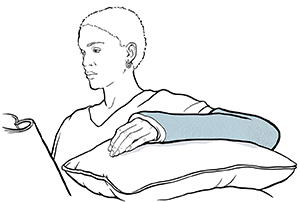An elbow dislocation may occur after injury, such as a fall onto an outstretched arm or in a car accident. When the hand hits a hard surface, the force is sent to the elbow. This tears ligaments and forces the bones out of the joint. Usually, no bones are broken. But the nearby nerves and blood vessels can be damaged.
Once the joint is put back in place, it will take about 6 weeks or more for the ligaments to heal. For simple dislocations, you will use a splint or sling for the first few weeks. You will need range-of-motion exercises or physical therapy early in your recovery. This will prevent the elbow joint from getting stiff. Later, you may need strengthening exercises.
In more severe cases, you may need surgery to realign the joint and repair the torn ligaments or broken bones. Most elbow dislocations heal fully. But there is some risk for arthritis or loss of full range of motion in that joint.
Home care
Follow these guidelines when caring for yourself at home:
-
Keep your arm elevated to reduce pain and swelling. When sitting or lying down, keep your arm above the level of your heart. You can do this by placing your arm on a pillow that rests on your chest or on a pillow at your side. This is most important during the first 2 days (48 hours) after the injury.
-
Put an ice pack on the injured area. Do it for 20 minutes every 1 to 2 hours the first day. You can make an ice pack by wrapping a plastic bag of ice cubes in a thin towel. As the ice melts, be careful that the cast or splint doesn’t get wet. You can put the ice pack inside the sling and directly over the splint or cast. Do not put ice directly on skin. Continue using the ice pack 3 to 4 times a day for the next 2 days. Then use the ice pack as needed to ease pain and swelling.
-
Keep the splint or cast completely dry at all times. Bathe with your splint or cast out of the water. Protect it with a large plastic bag, rubber-banded or taped at the top end. If a fiberglass splint or cast gets wet, you can dry it with a hair dryer on the cool setting.
-
You may use acetaminophen or ibuprofen to control pain unless another pain medicine was prescribed. If you have chronic liver or kidney disease, talk with your provider before using these medicines. Also talk with your provider if you’ve had a stomach ulcer or gastrointestinal bleeding or take blood thinners.
-
Don’t take part in sports or physical education until your provider says it’s OK to do so.
Follow-up care
Follow up with your provider as advised. Ask your provider when to start range-of-motion exercises. These will help keep the elbow from getting stiff.
If X-rays were taken, a radiologist may look at them. You will be told of any new findings that may affect your care.
When to contact your doctor
Contact your provider right away if:
-
The plaster splint or cast becomes wet or soft.
-
The fiberglass splint or cast stays wet for more than 24 hours.
-
Tightness or pain in the elbow gets worse.
-
Your fingers become swollen, cold, blue, numb, or tingly.
-
You can’t move your elbow as much as you could before.


